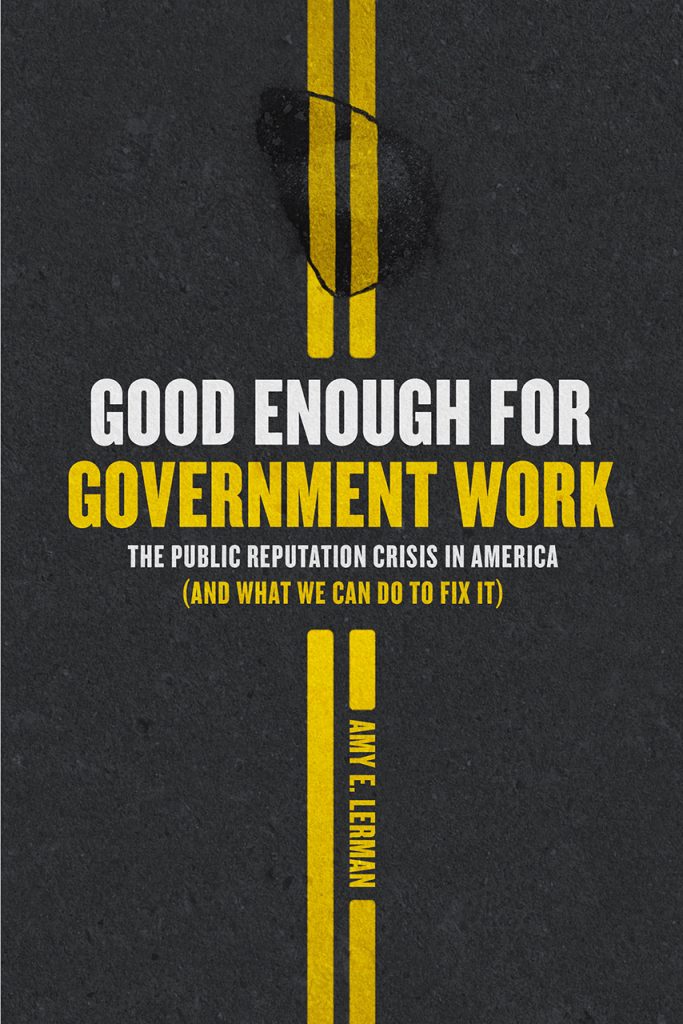What Atari and the “Worst Video Game of all Time” Can Teach Us About the Crisis in American Public Service
What does American public service have in common with a hastily produced video game adaptation of Spielberg’s E.T.? If you’ve endured the DMV—or, really, any overworked government office—you might find it difficult to identify which was described as “a confusing mess that left [people] frustrated and disoriented.” No, this isn’t a Yelp review of the USPS; it’s NPR’s take on the 1982 video game, published on the film’s thirty-fifth anniversary. Like the American government, Atari had to defend against a serious reputation crisis. E.T. would change how people saw Atari, and the company found it difficult to correct that perception despite the later success of Q*bert and Ms. Pac-Man. Today, the government faces the similar challenge of changing people’s minds about the quality of public services with serious consequences in some cases for its continued ability to provide them, including to those without access to private-sector alternatives.
The following is an excerpt from Good Enough for Government Work: The Public Reputation Crisis in America (And What We Can Do to Fix It) by Amy E. Lerman, where she describes what happened at Atari and what the “worst video game of all time” can teach us about American public service today.

What has happened to American government in the eyes of its citizens can only be described as a profound public reputation crisis. In the corporate world, a reputation crisis is an event or a series of events that causes consumers to reconsider the value or integrity of a private company. Reputation harm can stem from any number of sources: a tragedy outside a company’s control threatens to undermine confidence in its operations (e.g., Johnson & Johnson takes a substantial hit after several deaths from cyanide-tainted Tylenol are reported); illegal or unethical dealings tarnish perceptions of corporate responsibility (e.g., Volkswagen struggles to appease customers and regulators after it is caught rigging its emissions systems); dissatisfaction with the quality of a particular product or service drags down the reputation of an entire brand (e.g., the British supermarket chain Tesco fights to reassure consumers after its beef burgers are found to contain large quantities of horsemeat). Generally speaking, though, a crisis event of some kind or another casts doubt on a company’s competence or ability, or calls into question its commitment to social responsibility. Whatever the catalyst, the initial reputational damage can have long-term and far-reaching consequences, resulting in lowered share prices, lost revenue, layoffs, or even bankruptcy and dissolution.
For a classic example of how a reputation crisis can unfold, consider the video game Pong. An incredibly simple, two-dimensional table tennis simulation, Pong was the first game developed by Atari, in 1972, and was one of the very first multiplayer arcade video games. Pong was introduced by Atari at a local bar called Andy Capp’s Tavern, and the fact that it could be played as a social rather than solo game made it an immediate favorite among patrons. As one of Atari’s founders noted: “It was very common to have a girl with a quarter in hand pull a guy off a bar stool and say, ‘I’d like to play Pong and there’s nobody to play.’ It was a way you could play games, you were sitting shoulder to shoulder, you could talk, you could laugh, you could challenge each other. . . . In fact, there are a lot of people who have come up to me over the years and said, ‘I met my wife playing Pong.’”
The arcade game soon became a staple in bars, pizza parlors, and bowling alleys around the country, and Atari profited enormously from its commercial success; Pong brought in four times the money earned by other coin-operated games available at the time. Flush with orders for the arcade version, Atari began developing a Home Pong console that could be sold directly to consumers. Video game fanatics and historians have called Pong “one of the most historically significant” video game titles of all time and “the most important video game ever made,” crediting Home Pong with helping to launch the home gaming console market.
Atari followed on Home Pong’s success with the release of the Atari 2600. First sold in 1977, the system came with its now-iconic square joystick controllers and used removable cartridges rather than built-in games. This meant Pong could be followed by other iconic games, including Space Invaders, Frogger, and Centipede. The 2600 would come to both define and dominate the multibillion-dollar home video game market, and Atari became synonymous with home gaming. According to the director of the Videogame History Museum in Frisco, Texas, “Atari started it all. Atari is what brought video games into the mainstream.” By 1982, about 80 percent of the video game market was controlled by Atari, and Atari accounted for fully 70 percent of its parent company’s revenue. Fast forward to just a year later, and things looked decidedly different. By 1983, the video game market had crashed, and in just the second quarter of that year alone, Atari lost roughly $310 million. The company could barely give away some of its inventory. As a remarkable story in the New Yorker would later describe:
Demand for video games had fallen so much that the company [Atari] dumped fourteen trucks’ worth of merchandise in a New Mexico landfill and poured cement over the forsaken games to prevent local children from salvaging them. . . . The landfill in Alamogordo, New Mexico, about ninety miles north of El Paso, is the gaming world’s Roswell. This is partly, perhaps, because of its proximity to the real Roswell, but also because they’re both rumored to be hiding aliens: the dump was said to hold more than three million copies of the famously awful Atari adaptation of Steven Spielberg’s “E.T.: The Extra-Terrestrial.”
For Atari, the release of the E.T. video game had been a crisis event. Following the box office success of the film, its director, Steven Spielberg, tapped Howard Scott Warshaw at Atari to design the video game. (Warshaw had made a strong impression on Spielberg with his successful video game adaption of Raiders of the Lost Ark the year before.) But negotiations took longer than expected, leaving Atari with less than six weeks to get the game on store shelves in time for Christmas—compared to the standard lead time of six months or more. As one journalist described it, the result was that “in five, magical weeks, [Warshaw] took the blockbuster film E.T. and turned it into a horrible video game.” The game was “a commercial flop and a gaming disaster”; it was “primitive,” “a confusing mess that left players frustrated and disoriented,” and it would come to be hailed as “the worst video game of all time.” When the New Mexico landfill was finally excavated in 2014, the number of E.T. cartridges was closer to thousands than millions. The symbolism could not be ignored, however: the game was literally junk.
A confluence of factors led to problems at Atari—oversaturation of the market, competition from Nintendo and the home computer, and poor internal management—and the video game market as a whole would soon rebound from the 1983 video game crash and continue to thrive. But E.T. would mark a turning point in consumers’ perceptions of Atari. The company would go on to release games that were widely considered high quality, including Ms. Pac-Man and Q*bert, but Atari could not regain its former prominence, and consumers began defecting to competitors like Nintendo and Sega. By 1985, there was no coming back; “what was left of Atari’s once-mighty video-game division limped along from owner to owner for another two decades” until it was forced to declare bankruptcy in 2013. The relevance of this “once important” company and “titan of the arcade era” had “dwindled almost to nothingness by the turn of the millennium.”
This brief history of Atari provides a step-by-step case study of a corporate reputation crisis. As the story illustrates, what makes crisis events particularly damaging is that once an organization loses its reputation for quality and competence, that reputation is exceptionally hard to restore. While product or service quality might matter in establishing a company’s reputation, it is perceptions of quality that matter most in a reputation crisis. Whether or not Atari was still capable of producing quality games was important. But once customers lost confidence in the brand, the critical question was whether the company could successfully rebuild consumers’ faith. When private companies do not quickly rebound from a reputation crisis, they can soon find themselves in a downward spiral. First, a crisis event causes a loss in consumer confidence. As a result, corporate revenues decline. In response, the company makes cuts in order to reduce expenditures. In turn, this enforced austerity leads to an actual reduction in customer service or product quality, which merely serves to confirm consumers’ negative views. In this way, a reputation crisis quickly becomes a self-fulfilling prophecy, as customers defect and service quality declines. In this book, I argue that the same phenomenon can occur in the public sector—and indeed, has occurred in America over the past half century: American government is in the midst of a reputation crisis. Like reputation crises in the private sector, a public reputation crisis has three defining characteristics. First, large swaths of people come to hold predominantly negative perceptions of government. These beliefs are widespread enough that they become “common knowledge” and exist as shared understandings among citizens. Second, negative perceptions are highly resistant to change. Even in the face of new information about the cost, quality, or effectiveness of government, beliefs about government persist. Third, those who hold particularly negative perceptions begin to “opt out.” That is, when given the opportunity, individuals who believe government is wasteful and inefficient will choose to move from public services to private alternatives, when feasible. And when sufficient numbers of people opt out of public services, the result can be a decline in the objective quality of public provision, with consequences for us all.

Amy E. Lerman is assistant professor in the Goldman School of Public Policy at the University of California, Berkeley, and the author of The Modern Prison Paradox.
Good Enough for Government Work is available now! Find it on our website, online at any major booksellers, or at your local bookstore.